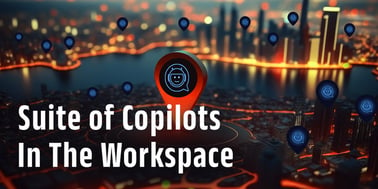Unless you have been living under a rock this past year, you like everyone else, have been swamped with information and tall claims around Artificial Intelligence (AI) and Generative AI (GenAI). If you’re like me, a businessperson trying to make sense of all of this, how and where do you start?
Furthermore, as the solutions lead at Coforge BPS, I am expected to make sense of this, find use cases that apply to business, define value propositions and talk smartly to both internal and external stakeholders about the endless possibilities that now manifest themselves.
Some use cases you may have heard of include smarter chatbots, creation of first drafts of documents, summarizing complex documents, code generation and testing, delivering concise content from a sea of knowledge resources, etc. However, this only scratches the surface.
The following is a window into my on-going process. If you have not started your own AI journey, I hope my Five Commandments on AI Enlightenment inspire you to begin today.
1. Thou shalt accept that AI and GenAI are here to stay.
The first step in any process of change is acceptance, whether enthusiastic or resigned. It took me a while to realize the power of AI and how it can be applied everywhere.
I don’t recall the specific Eureka moment that I finally decided to lean into all the buzz and hype around AI. It might have been the 100+ possible uses cases that were circulated by our CTO @Vic Gupta and his team around April 2023.
I had a moment of clarity soon after when I realized that, while AI has been around for a while, it is primarily using large quantities of historic data to find patterns and classify or group data. Based on those patterns, it can then choose the next best action in a sequence. GenAI, on the other hand, is actually capable of creating new content - be it language, images, or audio. I’m not getting into definitions here though, as there is a lot of great content already out there.
Once you find this Light, it is equally important to share the Light with people in your teams. This acceptance of change must flow downward, and you will have to craft your message to your audience. Current research shows that areas like service operations are most likely to be impacted from a headcount perspective.
So, you must have a good answer to the inevitable “Will I lose my job?” question. The truth is that the more repetitive and rules-based a job is, the more likely it will be impacted in some way. For example, it is unbelievable that in this day and age, people are still employed to triage shared email boxes and create cases in a CRM or ticketing system.
We are working along with our strategic partner @JAID.io to initially automate this triage function and then generate responses to some of the more basic email requests like status updates, etc. The flip side of this will be more interesting work for employees as they work ‘side-by-side’ with their AI colleagues.
2. Thou shalt attempt to educate thyself.
As I said earlier, there’s a lot of great content out there already. The trick is to find credible sources of information. Be aware of self-proclaimed experts. For starters, https://www.cloudskillsboost.google/ has an ‘Introduction to Generative AI Learning Path’. If nothing else, you’ll get a cool completion badge for your LinkedIn profile.
Best case, you realize that some terms are not interchangeable in usage! For example, AI is the broader concept and ML is a form of AI. So, AI/ML is a bit like chai tea (hint: you don’t need ‘em both as descriptors).
If you have an appetite for the minutia, academia is a great place to go looking for content. I will admit that my eyes glaze over when it comes to highly technical content such as this.
Talk to people who’ve been involved in the AI space for a while - remember AI has been around for a while, GenAI is however about a year old! These may be colleagues, vendor partners, research analysts and even clients.
I recall a conversation with a Coforge partner @Amit Ghole – CEO at inflooens – on how he and his team are infusing AI into their state-of-the-art mortgage process optimization platform. He mentioned three forms of AI used in his platform:
- Logical AI – triggering loan origination tasks based on a decision tree of prior events/circumstances, for e.g., automatically sending the applicant a form to sign if automated underwriting returns with an appraisal waiver.
- Predictive AI – following historic trends to predict outcomes, for e.g., tracking the ability to hit a closing deadline on a specific loan, based on historic task velocity.
- Generative AI – creating new content, for e.g., the ‘Loan Story’ functionality that creates a concise, reader friendly summary of the loan based on timeline events.
Lastly the adage of ‘follow the money’ applies here as well. Companies that are investing big into AI and GenAI must understand its capabilities and use cases in the context of specific industries. Looking around PE and VC websites for POVs is a good starting point to understand this revolution.
3. Thou shall exhibit a spirit of enquiry.
We are in the early stages of this hype cycle. Every company recognizes the need to get out ahead of the pack when it comes to the adoption of all forms of AI. Marketing departments are adept at stretching whatever little capabilities that exist - ‘if at all’ and create enticing pitches. While meeting with numerous technology providers, we have learned to be direct.
“What part of this product or solution is AI exactly?”
“Can you replicate those results starting with my data?”
“Are you willing to do a proof of concept (POC)?”
In our pitches to clients, we are transparent and collaboratively approach AI with a curiosity higher than that reserved for BAU matters. We have learned to pre-empt questions like those above and offer POCs with clearly defined business outcomes.
For example, for a large banking client, we are in the implementation phase of an Agent Assist module using Conversational AI through our partner @Uniphore. We worked with the client to create a project plan and signed up to deliver an outcome in the form of cost reduction to the tune of $2.8 million per annum.
That’s not a number to be scoffed at! However, I get that as a service provider, going after purely the cost side of the equation has been par for the course for a long time and customers are looking at this beyond to drive business effectiveness and experience. In our example above, technology augments human capital and beyond costs we expect to see higher NPS and faster resolution times.
4. Thou shall eat thine own dogfood
“Dogfooding” is the practice of using one’s own products or services to test real-world application. GenAI, specifically, is so new that most people have a hard time understanding how it works and believing that it can actually deliver on its promises.
Working with @Saurabh Gupta and his team at HFS Research, we came up with an approach to create use cases both internally and with customers who rate high on a two-by-two matrix of relationship strength and appetite for innovation.
The use case involving the bank and Uniphore is based on the bedrock of a two-decade long relationship with the bank. But most importantly, that use case is based on the willingness of Coforge to cannibalize its own revenue, as the solution has been deployed within our own Manila-based call center operation for that client. This is the only choice facing service providers, lest someone else come by and eat their lunch.
5. Thou shall create a culture of experimentation.
Let’s face it. This is probably the closest we’ll get to a Gold Rush in our lifetimes. GenAI is being compared to the creation of the Internet! Everything is fair game and the only way to discover ‘The Next Big Thing’ is through early adoption and experimentation.
This ties back to my First Commandment of acceptance. People in your organization must understand and accept that change (on a massive scale) is coming. They are either on the bus or are getting left behind.
Creating a culture of curiosity and experimentation where you fail fast, learn, and move on to the next best thing is important. The flywheel effect of shared learning and pulling together in the same direction is compounding.
Coforge just launched Quasar – a platform designed to build enterprise AI capabilities. It is meant to help organizations transform at scale and keep up with the world around them. With solutions and accelerators built around document processing, vision, speech, prediction etc., it enables companies to test use cases and build out-of-the-box solutions.
To conclude, if you want to know more about what we at Coforge are doing in specific areas please reach out. If you have an idea and need someone to build out a strawman or even a POC, let us know. In keeping with Commandment #3, if we don’t have anything beyond just an idea, I promise to let you know as such. We shall tread on paths unknown together!

Discover Nikhil Jaganathan's insights on Coforge's blog. Learn about AI, machine learning, and data science.
Related reads.
About Coforge.
We are a global digital services and solutions provider, who leverage emerging technologies and deep domain expertise to deliver real-world business impact for our clients. A focus on very select industries, a detailed understanding of the underlying processes of those industries, and partnerships with leading platforms provide us with a distinct perspective. We lead with our product engineering approach and leverage Cloud, Data, Integration, and Automation technologies to transform client businesses into intelligent, high-growth enterprises. Our proprietary platforms power critical business processes across our core verticals. We are located in 23 countries with 30 delivery centers across nine countries.



